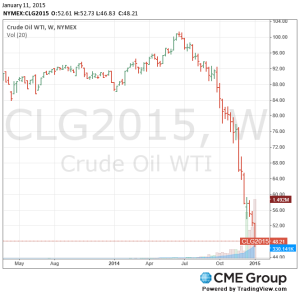
In the past six months, the cost of crude oil has dropped in half! Such a large price change in such a small timeframe suggests that new risks and opportunities abound for any business affected by energy prices. And who can think of any that aren’t impacted to some degree? The implosion in pricing means it is time to reassess your business’ energy risk profile.
In my last article, I presented some strategic ideas for producers, who typically benefit when energy prices rise and face difficulties when prices decline. In this article, I’ll look at energy marketers, who are often caught in the middle, literally and figuratively, when prices change. They are often selling energy to two classes of customer: those who are under contract based on prices in effect when they executed the contract; and those who purchase based upon current prices. Each class of business comes with its own unique risks. If a marketer also holds inventory, their balance sheets can be at risk for declining prices. Furthermore, a changing price curve can present unique opportunities to secure new business.
Strategic ideas for energy marketers:
1. Solicit new business. Lower prices typically benefit users. A marketer may now be in a position to offer users attractive pricing for future consumption. Consider marketing a new offering and protecting it with long positions in futures, swaps, forwards, or call options to lock in the market’s lower prices.
2. Bolster relationships with existing customers. If you have customers who locked in prices at higher levels than current pricing and who have unfulfilled commitments, make sure you are aware of the risk and keep tabs on customers who you fear may consider reneging on their commitments. Watch your accounts receivable balances closely. Work with customers to insure that they honor their commitments. Otherwise, you could be left holding a bag full of losses on financial derivatives with no offsetting business benefit.
3. Protect business at current price levels. If you have some unhedged fixed-price sales for which you are still at risk, consider placing protection at these lower levels. And, by the way, be grateful that the price didn’t go the other way!
4. Reassess price risk on inventory. If you own physical inventory of a commodity that has declined substantially in value, it may be time to reassess the risk on that asset. Hopefully, you’ve hedged the inventory price risk, so that now you have substantial gains on the financial derivatives used to hedge the risk. Consider cashing up those gains and either self-insure the remaining risk or purchase put options if you believe there is more downside price risk.
5. Lock in your cost. Just as producers are often substantial users of energy, so too are marketers. Their cost of delivering a commodity to market can be directly impacted by energy costs. Do current prices offer you the opportunity to attain a price level below your budgeted cost? Consider locking in your cost with long futures, swaps, forwards, or call options.
Check back soon for the last installment of this three-part series, in which I’ll address some strategic ideas for users of energy commodities.










